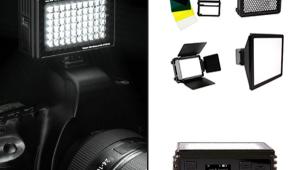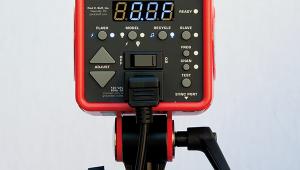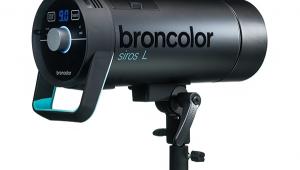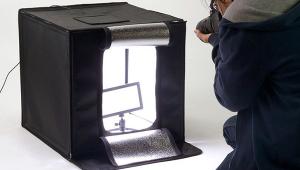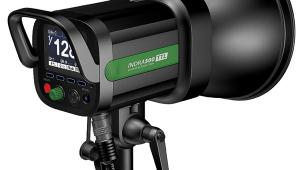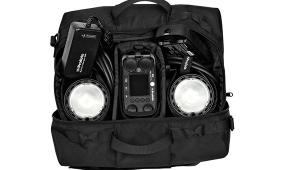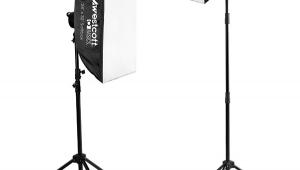Phottix Mitros Flash: An Affordable Shoe-Mount Model
One of the reasons you might consider a “third-party” shoe mount for your camera is simple—it’s usually less expensive, sometimes considerably so. Saving a few bucks is good, but perhaps some features are missing, or the construction isn’t as robust, or the resale value will be lower. But sometimes it just may be a smart choice, as I found when testing the Phottix Mitros flash for my Nikon.

The first thing I noticed when I took the flash out of the box was the case. It’s made of nylon with Velcro flaps and comes with a flat stand for mounting to a light stand. What I didn’t find was an instruction manual, but rather a thumb drive containing the multi-language instruction guide. Also included were a 3.5mm jack instead of a PC connection, a cord for updating via a USB connection, and a Nikon adapter for the Phottix battery pack. On top of the unit was a white plastic diffuser that clipped on both sides of the head. All in all, a nice, complete kit.
While you can check out all the specs online, there are a few things worth pointing out, some of them unique to Phottix. First, it has a battery meter. No more wondering how much battery power you have left. It also has an optical slave, a feature I very much like and use. Just set the unit to OS and it will see and respond to the flash from any other units, just like your studio lights. I also like the way it addresses overheating issues that can occur with multiple rapid firing. Some flash units will shut off—the Phottix will just slow down.
Add the ability to tilt/swivel in all directions, full CLS system capability, a locking metal foot, and a well-designed interface that can be picked up with just a little practice, and you’ve got a versatile set of features. (Phottix also sent me their Odin triggering system. While not the subject of this review, I got it just before a shoot, opened it up, loaded batteries, and proceeded to use it without even looking at any instructions. The system is really well designed and easy to understand. And Phottix already has a Canon compatible Mitros+ unit with the Odin system built in, and I assume the Nikon version can’t be far behind.)
Getting To Work Publicity Shots
I was contacted to do publicity photos by the manager of the band “Fight Me Up Johnny” (#1). One of the guys had an interesting house so we decided to do the photos there. It used to be a brick water tower so it is a round house with a single supporting beam in the center. It also contained some pretty unique objects and decorations.


© Steve Bedell
After establishing my location, I set up my main light, a Paul C. Buff Einstein unit with an umbrella. If this were a portrait, I’d probably want to shoot at about f/5.6 so the background wasn’t real sharp. But in this case I decided to keep everything sharp so I wanted a small f/stop, landing on f/13. I chose not to use a fill light for more drama.
With the main light established, I set up the two Phottix units to light the background and act as an accent light on camera right. I set the Phottix units to Optical Slave and then manually adjusted the power on each unit until I got the look I wanted. I did not use the supplied diffusers. One of the units is to the right, aimed at the suit of armor; the other is on the landing aimed at the coat of arms on the wall. I used a tripod and a slower shutter speed to pick up some of the warm light striking the ship.
Nikon D3, Nikon 18-105mm lens at 24mm, ISO 400, 1/20 sec at f/13.
Model Shoot
One of the great things about the current crop of top-of-the-line flash units is their ability to provide TTL combined with off-camera triggering. This allows you to create studio quality lighting on location without lugging around more cumbersome studio lighting units and battery packs. I took these photos of model Breana Nichole Miller to demonstrate the off-camera capabilities of the Phottix Mitros.
In this photo made in an alley between buildings (#2), I wanted to use an off-camera flash with just slightly more power than the ambient light. I metered the light at 1/250 sec at f/5. I used one Mitros as the master on my camera and used it to trigger the second Mitros on a stand camera left. I set it to read f/6.3. This gave me a slightly stronger light as the main, as you can see by the nose shadow. This also gave her a great catchlight in the eyes and cleans up any color issues. I did have a swivel mount for the Mitros on the light stand so I could aim it just where I wanted.

© Steve Bedell
Nikon D300, Nikon 18-105mm lens at 35mm, ISO 400, 1/250 sec at f/6.3.

High-Speed Sync
In this shot (#3), I wanted to check out the High-Speed Sync (HSS) capabilities of the flash. If you are unfamiliar with how HSS works, here’s a very short primer. With traditional flash and a focal plane shutter, the flash has to fire while the entire frame is open, usually at speeds up to a max of 1/250 sec. At higher speeds, the first shutter curtain has not fully opened before the second starts closing, resulting in partial illumination of the frame. HSS means the flash fires repeatedly, pulsing so that all sections of the frame are equally exposed. So, even though you may be using a wide f/stop, it taxes the flash unit because it has to flash several times in quick succession.


© Steve Bedell
Let’s see how well the Phottix Mitros handled the situation. I set Breana right in the middle of a courtyard in the middle of town. It was very bright and breezy and I didn’t want to get the buildings in the photo, so I got down low and aimed up to just include the trees and the sky. By shooting at a very high shutter speed I was able to match both the light on Breana and the sky, a hallmark of HSS photos. It was so bright out I couldn’t really see the results on my camera viewfinder all that well but when I got to view them on my monitor I was able to see that the Phottix performed perfectly. Once again I used one unit on the camera as the master to fire the second unit on a light stand.
Nikon D300, Nikon 18-105mm lens at 26mm, ISO 400, 1/8000 sec at f/4.5.
Conclusion And Recommendations
I used the two flash units over a couple of months at candid events, for indoor sports, outside, and in the studio. I found them reliable, repeatable, and rugged, and they carry a two-year warranty. If you’re in the market for a versatile and full-featured flash for your Nikon, Canon, or Sony, I’d highly suggest you check them out. Phottix has really done their homework here and for about $200 less than a comparable OEM unit you get a feature-laden, well-built flash that would be at home in any professional’s camera bag.
The Phottix Mitros flash has an MSRP of $299. For more information, contact Phottix at www.phottix.com, or OmegaBrandess (distributor) at www.omegabrandess.com.
Steve Bedell has been a portrait photographer for over 25 years. To subscribe to EPhoto, a free e-mail newsletter with tips for photographers, contact Bedell via e-mail at: smbedell@gmail.com. Also ask about his lighting DVDs.
- Log in or register to post comments


